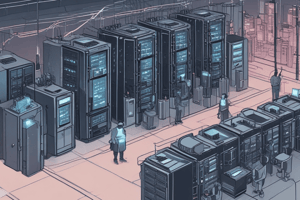Podcast
Questions and Answers
What percentage of an IT department's power usage can cooling account for?
What percentage of an IT department's power usage can cooling account for?
- 25%
- 75%
- 63% (correct)
- 50%
What unit is commonly used to express power consumption in datacenters?
What unit is commonly used to express power consumption in datacenters?
- British Thermal Units (BTUs) (correct)
- Watts
- Kilowatt-hours (kWh)
- Joules
Which of the following is a cause of increased cooling costs in datacenters?
Which of the following is a cause of increased cooling costs in datacenters?
- Decreased equipment density
- Irregular heat load (correct)
- Inefficient power consumption
- Solar heating effects
What does the 'flood-cooling impulse' refer to in datacenters?
What does the 'flood-cooling impulse' refer to in datacenters?
How is electrical power consumption measured?
How is electrical power consumption measured?
What is a key component of datacenter cooling management?
What is a key component of datacenter cooling management?
What was the estimated global spending on cooling datacenters in 2007?
What was the estimated global spending on cooling datacenters in 2007?
What does an increase in heat density in racks indicate?
What does an increase in heat density in racks indicate?
What is the primary benefit of using a water-side economizer in a datacenter?
What is the primary benefit of using a water-side economizer in a datacenter?
Which environmental condition is optimal for the operation of a water-side economizer?
Which environmental condition is optimal for the operation of a water-side economizer?
What is a disadvantage of using traditional air-conditioning systems in a datacenter?
What is a disadvantage of using traditional air-conditioning systems in a datacenter?
How do smaller air-to-air coolers provide cooling to a room?
How do smaller air-to-air coolers provide cooling to a room?
What feature does HP's Dynamic Smart Cooling system use to optimize cooling?
What feature does HP's Dynamic Smart Cooling system use to optimize cooling?
Which type of on-demand cooling system requires a standard garden hose connection?
Which type of on-demand cooling system requires a standard garden hose connection?
Which statement regarding maintenance costs is accurate about fluid-chilled cooling systems?
Which statement regarding maintenance costs is accurate about fluid-chilled cooling systems?
What voltage circuit is typically utilized for larger on-demand cooling units mounted outside buildings?
What voltage circuit is typically utilized for larger on-demand cooling units mounted outside buildings?
What was the initial power consumption to cool the datacenter before optimization?
What was the initial power consumption to cool the datacenter before optimization?
Which method is used by Dynamic Smart Cooling to regulate temperature in a datacenter?
Which method is used by Dynamic Smart Cooling to regulate temperature in a datacenter?
What is a potential consequence of inadequate air exchange in a datacenter?
What is a potential consequence of inadequate air exchange in a datacenter?
In the hot aisle/cold aisle configuration, where are the cool sides of equipment positioned?
In the hot aisle/cold aisle configuration, where are the cool sides of equipment positioned?
What is the ideal air exchange rate for high-density datacenters?
What is the ideal air exchange rate for high-density datacenters?
What is one disadvantage of raising the floor in a datacenter?
What is one disadvantage of raising the floor in a datacenter?
What happens when cooling systems are placed parallel to the rack of equipment?
What happens when cooling systems are placed parallel to the rack of equipment?
What is a common practice to maintain cooling efficiency in datacenters?
What is a common practice to maintain cooling efficiency in datacenters?
Why is it important to select racks with good airflow?
Why is it important to select racks with good airflow?
What is the recommended placement for diffusers in a data center?
What is the recommended placement for diffusers in a data center?
What should be minimized to maintain effective cooling in a raised flooring system?
What should be minimized to maintain effective cooling in a raised flooring system?
How can computational fluid dynamics (CFD) models assist in a large data center?
How can computational fluid dynamics (CFD) models assist in a large data center?
What is a key factor in ensuring return plenums function effectively?
What is a key factor in ensuring return plenums function effectively?
What is a benefit of using redundant air handlers during normal operations?
What is a benefit of using redundant air handlers during normal operations?
What is suggested for under-floor supply plenums to ensure proper airflow?
What is suggested for under-floor supply plenums to ensure proper airflow?
What is a recommended approach to improve fan efficiency in a data center?
What is a recommended approach to improve fan efficiency in a data center?
What is one advantage of upsizing the duct, plenum, and piping infrastructure in data centers?
What is one advantage of upsizing the duct, plenum, and piping infrastructure in data centers?
Why are variable-speed motor drives beneficial when used with chillers and pumps?
Why are variable-speed motor drives beneficial when used with chillers and pumps?
What should be introduced early in the design phase to minimize costs?
What should be introduced early in the design phase to minimize costs?
Which of the following is a suggested method to examine energy efficiency in existing facilities?
Which of the following is a suggested method to examine energy efficiency in existing facilities?
What role does documented reasoning play in the project decision-making process?
What role does documented reasoning play in the project decision-making process?
What is a potential drawback of upsizing cooling towers?
What is a potential drawback of upsizing cooling towers?
Why is it important to involve all key stakeholders in the decision-making process?
Why is it important to involve all key stakeholders in the decision-making process?
What should be the focus when setting quantifiable goals in facility design?
What should be the focus when setting quantifiable goals in facility design?
Flashcards are hidden until you start studying
Study Notes
Cooling Costs
- Cooling can account for up to 63% of an IT department's power usage
- Electricity is measured in kilowatt-hours (kWh)
- A 100-watt light bulb uses 100 watt-hours of electricity in 60 minutes
- Ten 100 W light bulbs use 1 kWh of electricity per hour
- Companies worldwide spent approximately $29 billion on datacenter cooling in 2007, a 400% increase from 2000
Causes of Cooling Costs
- Cooling is a major component of power consumption and IT budgets
- Increased server and storage device deployment leads to increased power consumption
- Higher computing power in confined spaces increases heat density within racks
- Irregular heat loads in datacenters are exacerbated by poor heat management planning
- Overcooling datacenters can significantly increase costs
Calculating Cooling Needs
- All equipment in a server room generates heat
- Humidity changes in datacenters impact cooling needs
- Filtration and humidification can be more expensive than using a regular air-conditioning system
Economizers
- Water-side economizers use evaporative cooling to produce chilled water for datacenter cooling, especially effective in environments with temperatures below 55 degrees Fahrenheit for 3000+ hours per year
- Economizers can reduce chilled-water-plant energy consumption by up to 75%
- Reduce maintenance costs by minimizing or eliminating chiller operation
- Prevent contaminants and humidity changes from entering the datacenter
- Typically incorporated into chilled water or glycol-based cooling systems
On-Demand Cooling
- Provide temporary cooling when central air conditioning fails
- Two types: air-to-air and water-based
- Air-to-air coolers can be wheeled into rooms needing cooling
- Smaller air-to-air coolers use flexible ductwork and standard 110-volt outlets
- Larger air-to-air units are mounted outside buildings with cool air ducted through a window, operating on 208-to-230-volt circuits
- Water-based systems are larger units, using garden hoses to supply water for cooling
HP's Solution
- Dynamic Smart Cooling uses sensors to control datacenter temperature
- HP labs reduced datacenter cooling power from 45.8 kW to 13.5 kW using Dynamic Smart Cooling
- System adapts to changing workloads by adjusting cool air delivery based on computer needs
- Sensors on computers detect warming and signal air conditioners to deliver more cool air
Optimizing Airflow
- Air exchange rate is crucial for optimal cooling
- Normal offices require air exchange twice an hour
- High-density datacenters require air exchange 50 times an hour
- Insufficient air exchange can lead to overheating before cool air reaches equipment
Hot Aisle/Cold Aisle
- Equipment draws air from the front and exhausts air from the rear
- Cold sides of equipment are arranged together, hot sides face each other
- Allows equipment to draw in cool air, rather than preheated air from neighboring racks
- Cold aisles have perforated floor tiles to draw cooler air from raised floors
- Floor mounted cooling is placed at the end of hot aisles, not parallel to racks
Raised Floors
- Datacenters are built on raised floors 18 to 36 inches high
- Higher floors allow more air distribution under the floor
- Higher floors can disrupt day-to-day operations and increase height
Supply Air Directly to Heat Sources
- Cooling only the devices generating heat is more cost-effective than cooling the entire datacenter
- Use diffusers designed for datacenter cooling directly at equipment intakes
- Place diffusers near equipment intakes, avoiding heat exhausts
- Minimize air leaks through cable accesses in hot aisles
- Use computational fluid dynamics (CFD) models to optimize cooling unit placement
- Properly sized return plenums allow adequate air flow
- Under-floor supply plenums must be large enough to service equipment
Fans
- Fans consume significant power, especially when operating simultaneously
- Use low-pressure drop air handlers and ductwork for efficient airflow
- Use redundant air handlers at lower speeds for greater efficiency
Design for Your Needs
- Datacenters are often underutilized
- Upsize duct, plenum, and piping infrastructure for future scalability
- Use variable-speed motor drives on chillers and pumps for improved part-load performance
- Consider efficient techniques like medium-temperature cooling loops and fluid-side economizers
- Upsizing cooling towers improves chiller performance and economizers
Putting Everything Together
- Implement organization-wide considerations for efficient cooling
- Use life cycle cost analysis for decision-making
- Involve key stakeholders in project planning
- Document and clarify design decisions
- Set quantifiable goals based on best practices
- Introduce energy optimization early in the design phase
- Include integrated monitoring, measuring, and control systems
- Benchmark existing facilities and track performance
- Evaluate potential for onsite power generation
- Provide facility operation staff with site-specific training
Studying That Suits You
Use AI to generate personalized quizzes and flashcards to suit your learning preferences.





